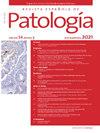Impact of HPV detection and p16-Ki67 expression on prognosis in anal cancer patients
IF 0.5
Q4 Medicine
引用次数: 0
Abstract
Introduction
HPV infection has been associated with squamous cell carcinoma of the head and neck, genital tract and anal canal. HPV has two oncogenic genes, including E6 and E7, which are responsible for carcinogenesis. Ki67 and p16 have been used as biomarkers of HPV genome integration in the host cell.
Aim
To analyse the prognostic role of HPV status and p16/Ki67 expression in malignant lesions of the anal canal.
Methods
A retrospective study conducted from 2013 to 2016, including 40 biopsies.
Results
Histologic classification of the samples was: 9 samples of invasive carcinoma (ASCC); 9 of anal intraepithelial neoplasia (AIN) II/III; 8 condylomas; 14 non-tumoral lesions. For HPV detection we used nested-real time PCR for E6/E7. The determination of p16INK4a and Ki67 was carried out by immunohistochemistry. Additionally, demographic information was analysed. Among the 9 ASCC cases, 8 were p16-Ki67 positive and high-risk HPV positive. Of the 9 AIN II/III cases, 8 (88.8%) were HR-HPV and p16-Ki67 positive; all cancer cases were HPV-16. Out of the 8 condyloma cases, 2 (25%) were HR/LR HPV, 5 (62.5%) were LR-HPV, and 100% p16/Ki67 negative. Of the 14 non-tumoral lesions, all biomarkers tested negative.
Discussion
High- and low-risk HPV genotyping helps predict the prognosis of anal canal lesions. High-risk HPV infection and p16 overexpression are associated with malignant tumoral lesions.
HPV检测及p16-Ki67表达对肛门癌患者预后的影响
hpv感染与头颈部、生殖道和肛管的鳞状细胞癌有关。HPV有两个致癌基因,包括E6和E7,它们是致癌的原因。Ki67和p16已被用作宿主细胞中HPV基因组整合的生物标志物。目的分析HPV状态及p16/Ki67在肛管恶性病变中的表达对预后的影响。方法对2013 - 2016年40例活检进行回顾性研究。结果:9例为浸润性癌(ASCC);肛门上皮内瘤变(AIN) II/III型9例;8湿疣;14个非肿瘤病变。对E6/E7采用巢式实时PCR检测。免疫组化法检测p16INK4a和Ki67。此外,还分析了人口统计资料。9例ASCC中p16-Ki67阳性8例,高危HPV阳性8例。9例AIN II/III型病例中,8例(88.8%)为HR-HPV和p16-Ki67阳性;所有癌症病例均为HPV-16型。在8例尖锐湿疣病例中,2例(25%)为HR/LR HPV, 5例(62.5%)为LR-HPV, 100%为p16/Ki67阴性。在14个非肿瘤病变中,所有生物标志物检测均为阴性。高危和低危HPV基因分型有助于预测肛管病变的预后。高危HPV感染和p16过表达与恶性肿瘤病变相关。
本文章由计算机程序翻译,如有差异,请以英文原文为准。
求助全文
约1分钟内获得全文
求助全文
来源期刊

Revista Espanola de Patologia
Medicine-Pathology and Forensic Medicine
CiteScore
0.90
自引率
0.00%
发文量
53
审稿时长
34 days
 求助内容:
求助内容: 应助结果提醒方式:
应助结果提醒方式:


